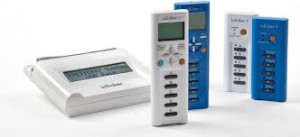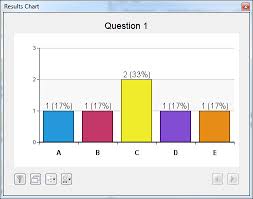I>clickers: Making Assessment Easy in the Classroom
By: Dylan, Cole, and Eddie
Introduction:
For as long as I can remember, teachers have been using the same old boring techniques to educate students and I would know because I am one. Teachers usually give you a lecture and sent you home with a homework assignment without fully knowing if students understood the material or not. However, what if I were to tell you that there is a not only a better way to educated our students but also give them a voice without even them speaking.
This better way is called I>clicker which is a fairly new technology that allows teachers of today to interact with students not only in class but outside of the classroom as well. But there is more, we all know that in today’s society, people are very dependent of their personal devices such as cell phones, and so why not give our students the opportunity to use these personal devises in a productive way in our school system. A ninth grade student Eddie says, “When I study at home for a quiz or a test even though I finish the study guide, I never know if I am doing the problems right or wrong because I don’t have the answer sheet until the next day and don’t know which content areas of the test I should focus on and spend more time studying.” With the I>clicker, this problem is history. This technology allows the teacher to give instant feedback which will help the students identify which area they need to focus more on while studying and therefore be more prepare for the test or quiz.
Now, I know some of you teachers may have some concerns about this technology and I will do my best to clarify any sort of questions you may have. Because it is a new technology one may this that is going to be a complicated set up and is going to be difficult to use, have complex software…etc. However this technology is very easy to set up and easy to use even a fifth grader can use it. There are many advantages in having the I>clicker in our school system. Whether it is to give our students a voice, keep them engaged and give immediate feedback. Times changed and we have to change with it, the generation of today want things faster and at their fingertips and so why not give it to them. The I>clicker success for students of our future.
How to Acquire an iclicker:
Currently on their website there are 4 options which include iclickers when it comes to making the purchase. You can either buy an iclicker-2 with REEF Polling or without or buy an iclicker+ with REEF Polling or without. I would like to note that the prices I am about to list are if you were to buy them from amazon.com which is where the links on their website will take you; however, they instruct you to call for packaging deals if you are an instructor or administrator looking to make bulk purchases. Therefore, the prices I am listing are an over-price of what it would cost if you were to buy in bulk. The prices listed on amazon.com are as follows:
iclicker+ with REEF Polling: $39.57-$48.33
iclicker+ : $44.73
iclicker-2 with REEF Polling: $31.98-$52.67
iclicker-2: $52.52
If you were to buy these individually the cost would be quite a bit depending on how many students there are in a class. Also, it would be my suggestion to purchase them with REFF Polling since the price with is barely more than without. I feel as though this product is worth the cost and the time spent to negotiate with administrators and i>clicker specialists. The full process for how negotiations might be made will not be covered in this article since it would be unprofessional to fake a purchase to get that information. However, I believe that even the prices above are not too costly for such a great purchase. If the cost becomes an issue grants can always be applied for and donations requested.
How the iclicker Works and How to Use it:
The iclicker is an extremely useful tool for all teachers. While a bit expensive (unless the students are able to download the application on their cell phones, either Iphone or Android), the iclicker can be used to widen student engagement in a classroom setting. The way it works is the teacher has a “master” remote called the iclicker 2 along with the iclicker base. The iclicker 2 is what the instructor uses to guide the lesson and go to the next slide, show answer, etc. The iclicker base is the receiver to all the students’ iclickers. Since the devices are wireless, there must be something to receive the signal. The classroom setting would be the teacher near the projector and the iclicker base holding the iclicker 2 (which as a reminder is the control clicker). The students would either have a classroom set of iclickers, their own person clickers, or be using the application in their cell phones (all of these options work, but it is up to the teacher and the school to allocate resources efficiently and finding the best way based on that–it is also an option to have half a class set and the other half using the application on their phones).
Like any lesson, the teacher will have to create the questions, multiple choice, before the lesson in order for it to run smoothly. The teacher is able to put how many answers and how much time should be allocated for each question. To introduce the question to the students, it could be through a powerpoint or brought up sporadically whenever the question is appropriate. The great thing about the question process of the iclicker is it shows on the screen how many total “clickers” have answered; so if you have a class of 30 students, you know all of them have answered the question once that number hits 30. Related to that, if only 10 out of 30 students have answered when the time is almost up, the teacher can give more time. For instance, if the students are struggling more than you thought they would and you only gave 30 seconds for the question, you are able to increase the time to 45 seconds (or even add 15, 30, 45 seconds etc. right before the time hits 0). This is a fantastic tool if you are unknowing of the caliber of the students knowledge or are in a good enough mood to give the students more time. After the time hits 0, another fantastic quality the iclicker device has is it can reveal the correct answer and the percentage and number of students which picked each answer (for instance, if the correct answer was B, the chart at the end might tell you 50% of students, 15 total, chose B, 10% of students, 3 total, chose A, 10% of students, 3 total, chose C, and 30% of students, 9 total, chose D). This is an exc ellent way to assess student learning immediately and plan your next lesson adequately and appropriately. This also provides immediate feedback to the students showing them what exactly they need to work on. A feature that the iclicker has is it saves the students’ iclicker I.D.s so that after the lesson, the teacher is able to see which individual students chose which answers, which are anonymous to the students themselves. This is a great way to influence participation and even make the questions worth points or extra credit. After the chart is shown with the correct answer, the teacher may pause the lesson and go over the problem and the correct way to do it before moving on. Another option is to choose a student who got the answer correct and have them work out the problem on the board (this increases student participation and development!) There are many options that teachers have while using the iclicker with students, but it is an important resource that teachers should know about and at least try (even a substitute clicker) once for a more engaging and rewarding classroom experience.
ellent way to assess student learning immediately and plan your next lesson adequately and appropriately. This also provides immediate feedback to the students showing them what exactly they need to work on. A feature that the iclicker has is it saves the students’ iclicker I.D.s so that after the lesson, the teacher is able to see which individual students chose which answers, which are anonymous to the students themselves. This is a great way to influence participation and even make the questions worth points or extra credit. After the chart is shown with the correct answer, the teacher may pause the lesson and go over the problem and the correct way to do it before moving on. Another option is to choose a student who got the answer correct and have them work out the problem on the board (this increases student participation and development!) There are many options that teachers have while using the iclicker with students, but it is an important resource that teachers should know about and at least try (even a substitute clicker) once for a more engaging and rewarding classroom experience.